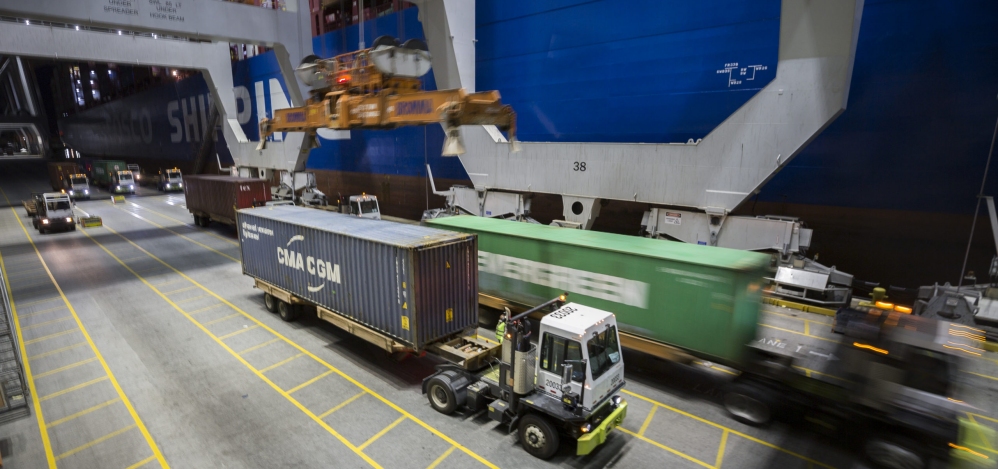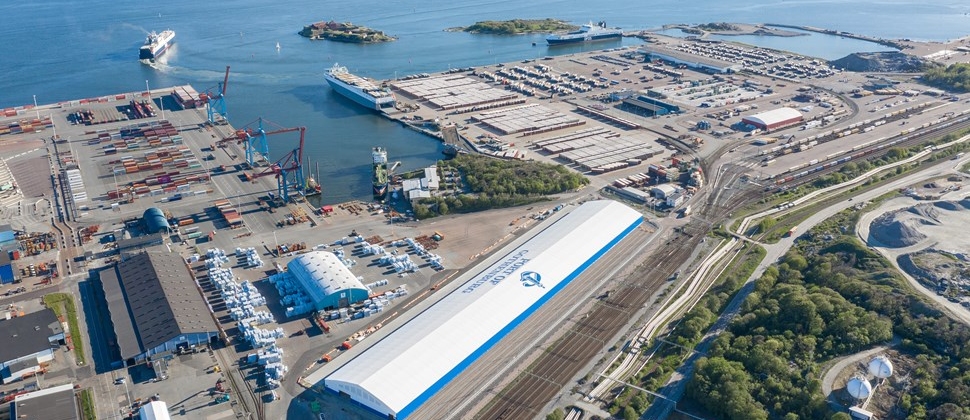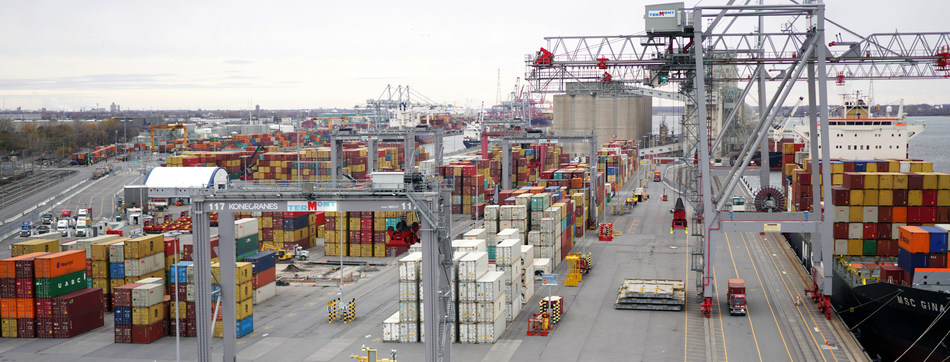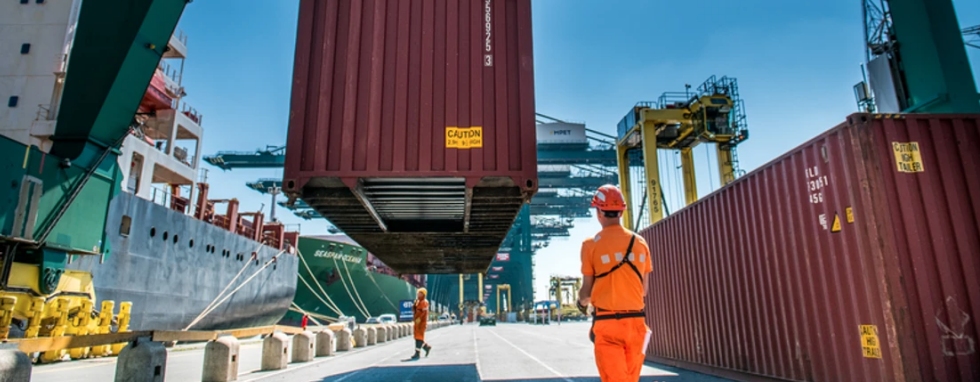|

Georgia Ports Authority Sets Tonnage Record for FY2020
July 27, 2020 – The Port of Savannah handled 4.44 million twenty-foot equivalent container units in Fiscal Year 2020, down less than 1 percent compared to the previous year. Despite COVID-19 disruptions, total tons crossing all GPA docks reached a record 37.77 million, up 0.6 percent, or 223,000 tons, compared to FY2019. Container tons grew 2 percent (560,440 tons) to reach 33.5 million tons for the year, another record.
“Cargo volume reductions related to COVID-19 were offset by the strength of our export markets and record volumes earlier in the year,” said Griff Lynch, GPA’s executive director. “This year’s better than expected performance is the result of excellent teamwork starting at the top with Governor Kemp and our board of directors who have been champions of our ports, to our GPA team members along with the International Longshoremen’s Association, the shipping lines, stevedores, trucking and rail — you have never given in or given up throughout the crisis. Thank you for your commitment and perseverance.”
Even during challenging times, port activity coupled with ongoing expansion projects such as the harbor deepening and Mason Mega Rail have quickened the pace of commercial infrastructure investment. According to the latest report from Colliers International, 5 million square feet of industrial space are currently under construction in the Savannah market. In addition, Savannah is home to a total of 74.4 million square feet of warehouse and manufacturing space.
“What sets Savannah apart from the competition is the sheer capacity of the port’s ever-expanding footprint, on and off the terminal,” said Will McKnight, GPA’s board chairman. “Not only are we focused on the future and providing even greater value to our customers, but we have nearly unlimited potential and capacity to grow our business.”
The Port of Savannah’s status at the third-largest container gateway in the country, the nation’s top exporter of containerized agricultural goods and the fastest growing port over a 10-year period, continues to be a strong draw for economic development. Just recently, Port City Logistics announced an $80 million, 1.1 million square-foot development in the Savannah market as two major resin exporters were building out a total of 2 million square feet of new space.
In Northwest Georgia, the Appalachian Regional Port (ARP) handled more than three and a half times the cargo it did the year before, moving 27,132 containers, up 19,610 boxes. “As more customers learn the value the ARP brings to their operations, the facility continues to gain traction and build momentum,” Lynch said. “The inland port is a real success story for GPA, and we forecast business there to continue growing.”
At the GPA board meeting Monday, Lynch reported the first nine of 18 Mason Mega Rail tracks are now moving cargo at the Port of Savannah, two new mobile harbor cranes have been added to Savannah’s Ocean Terminal and a new container yard will be completed at Ocean Terminal by year’s end. Twenty new rubber-tired gantry cranes are slated to arrive at Savannah terminals by December, three new rail-mounted gantry cranes are scheduled to go into service by the end of FY2021, and construction will start soon on the upcoming straightening of Berth 1 at Garden City Terminal to handle more 15,000-TEU vessels. GPA is also upgrading Berth 2 at Colonel’s Island in Brunswick for dedicated Roll-on/Roll-off service.
Lynch said adding new container yard space, doubling rail capacity to 2 million TEUs per year, and growing the fleet of yard and vessel cranes are all parts of GPA’s plan to increase annual capacity from 6 to 11 million TEUs. “We’re confident in the long-term strength of the U.S. economy and our ability to help port users reach their customers more effectively,” Lynch said. “We’re building now to be ready to take advantage of new opportunities.”
Georgia’s deepwater ports and inland barge terminals support more than 439,000 jobs throughout the state annually and contribute $25 billion in income, $106 billion in revenue and $2.9 billion in state and local taxes to Georgia’s economy. The Port of Savannah handled 8.5 percent of U.S. containerized cargo volume and 10 percent of all U.S. containerized exports in FY2017. |
|

Port of Gothenburg Announces New Transshipment Terminal Soon To Become Operational
July 22, 2020 - A new transshipment terminal, located between the Port of Gothenburg container and ro-ro terminals, is gradually emerging. The terminal will receive incoming forest products by rail from Swedish mills and then transfer the products to containers for onward transport to various parts of the world. Volumes equivalent to 60,000-100,000 twenty-foot-equivalent units will be handled at the terminal each year.
The terminal, named the Svea Terminal, will offer 45,000 square metres of storage space. Around half the area, 21,600 square metres, is covered by the world’s largest storage tent, which was recently erected.
On the inside, the goods can be loaded into weather-protected containers and the area will be used partly for intermediate storage. The tent measures 360 metres by 60 metres and is up to 15 metres in height. The steel beams that support the tent weigh 450 tonnes.
“It’s not exactly a camping tent, but rather a fully equipped storage facility that meets all our demands and specifications, and at the same time offers a cost-effective operating solution,” said Arvid Guthed, Vice President Port Development, Gothenburg Port Authority.
World-class rail volumes
The terminal has rail connections and can house a 350-metre train. By doing so, sensitive products such as pulp and paper rolls can be transported directly into the facility by rail, where under cover they are transferred into a container before being loaded on board the ship.
At present around 60 per cent of the Port of Gothenburg container volumes arrive at or leave the port by rail. A figure that makes the Port of Gothenburg world-class in terms of rail operations.
“This is the result of the long-term investment in the Railport concept, which connects the whole of Sweden to the Port of Gothenburg by rail,” said Claes Sundmark, Vice President, Sales & Marketing, Gothenburg Port Authority.
Investments include the current expansion of the double-track Port Line and construction of the Arken Combi Terminal, which has already led to a substantial reduction in road traffic in Gothenburg. A further investment is APM Terminals’ modernisation and capacity expansion on its marshalling line, where trains are loaded and unloaded inside the container terminal.
Climate-friendly investment
The Port of Gothenburg has also adopted one of the world’s most forward-thinking climate goals where they have undertaken to reduce the whole of the port’s carbon emissions by 70 per cent through to 2030. One of the ways of achieving this goal is to continue investing offensively in the Railport concept in an effort to increase the proportion of rail-borne freight even further.
“The Svea Terminal is ideally suited to realising this ambition. The Terminal will increase rail capacity even further and we will be able to double forest product volumes arriving at the port by rail. It also means that we can reduce the port’s climate footprint and provide further conditions that will allow our customers to make climate-smart choices,” said Claes Sundmark.
Experienced operator
When it comes to operating the terminal, a highly proficient company with many years’ experience of transshipment at the Port of Gothenburg has taken on the task.
“With our experience and the good preconditions at the terminal to facilitate effective crossdocking and transshipment of overseas freight, the terminal will be a major asset for the port and the Swedish forest industry,” said Mikael Bergman, MIMAB chief executive.
SOURCE: Port of Gothenburg |
|

Port of Montreal Using Artificial Intelligence to Optimize Its Logistics Operations
July 22, 2020 - Thanks to artificial intelligence (AI), the Port of Montreal will be able to benefit from a new predictive tool that optimizes port logistics, letting the Port improve its operational planning and positively impact the transit times for containerized cargo in the supply chain, especially for rail freight.
Daniel Dagenais, Vice-President, Operations at the Montreal Port Authority (MPA), stated: "This project is another critical milestone towards the ‘Smart Port’ vision we are implementing. It will benefit all stakeholders involved in the chain by reducing cargo delays and transit time while maximizing throughput to our major logistics hub.”
This AI solution aims to optimize freight train planning based on variables such as ship arrivals, rail car deliveries, storage capacity, workforce availability and more to achieve optimal fluidity.
The project is headed by the MPA in partnership with terminal operators Montreal Gateway Terminals Partnership and Termont Montreal Inc., as well as with EI Systems and Canscan. It was developed in collaboration with IVADO Labs, a startup specializing in the development of AI solutions with unique expertise in logistics.
This is the second project benefiting the MPA and funded by the Government of Canada through Supply Chain and Logistics Excellence AI (Scale AI), an investment and innovation cluster that accelerates the application of artificial intelligence for supply chains. It is noteworthy that last May, the Port of Montreal partnered in a project that makes it possible to use AI to accelerate the handling of goods deemed "critical" in the current COVID-19 pandemic.
SOURCE: Port of Montreal |
|

Port of Antwerp Limits Damage During Corona Crisis
Total goods throughput down by 4.9%; first signs of recovery visible
July 8, 2020 - The total throughput of the Port of Antwerp fell by 4.9% in the first half of the year compared to the same period in 2019. After a strong first quarter, the port experienced a decline in the transhipment of all flows of goods, with the exception of the container sector. Despite the impact of the coronavirus crisis on global production and logistics chains and a pandemic-driven drop in demand, the port remained 100% operational.
Container traffic status quo
Container traffic increased in the first quarter of the year, but felt the effects of cancelled sailings from April onwards. Nevertheless, for the period January-June 2020, container traffic recorded a slight increase of +0.4% in TEUs compared to the same period last year (with April and May 2019 as absolute record months). The number of calls made by vessels decreased, but this was compensated by a higher average volume per vessel and by additional calls on top of the normal sailing schedules. Notable climbers in this special period were the transhipment of pharmaceutical products, e-commerce and health foods. At the beginning of June, the port also welcomed the world's newest largest container ship, the HMM Algeciras with a capacity of 23,964 TEU.
Slight recovery in breakbulk sector in June
Since mid-2019, global trade issues continue to adversely affect goods flows in the conventional breakbulk sector. This has culminated in an overall 29% decrease for the period January-June compared to 2019, with inbound and outbound flows being affected to the same extent. The throughput of iron and steel, the most important freight group within this sector, experienced its best month of 2020 in June but a total decrease of 33.1% for the first six months of this year.
The automotive sector was already struggling in 2019 with the introduction of stricter rules on passenger car emissions in Europe and this trend continued in 2020. From March onwards, the coronavirus crisis only compounded this situation: less exports of new European cars, less supply of new Asian cars and downtime in the second-hand market due to travel restrictions. As a result, the total RoRo throughput fell by 21.8%.
Bulk cargo declined due to reduced demand for energy
While the transhipment of coal continued to grow in the first quarter, it came to a standstill in the second quarter. This resulted in a 13.1% drop in dry bulk transhipment in January-June 2020 compared to the same period last year. This decrease is partly attributable to the growing supply of green energy, which reduced the need for coal, partly by reduced demand for coal from the steel sector and partly by a strong second quarter in 2019. Fertilisers, which represent the largest share of dry bulk volumes, grew slightly (+1%) compared to January-June 2019.
Liquid bulk decreased by 7.5% compared to the first half of 2019 because of the coronavirus crisis, which wiped out demand for oil products, combined with price wars. Thanks to the gradual lifting of the coronavirus measures and the recovery of the oil price, fuel throughput increased in May and June. Moreover, chemicals decreased by 8.9% compared to the first six months of 2019, mainly due to reduced demand from the automotive sector.
Seagoing vessels
Over the past six months, 6,797 seagoing vessels called at Antwerp, representing a decrease of 5.6% compared to the same period in 2019. The gross tonnage of these vessels fell by 7.9% to 193 million.
Port of Antwerp grants postponement of payment
Following discussions with the Antwerp port community about the consequences of the coronavirus crisis, the Port Authority decided to grant a postponement of payment for the shipping and inland navigation dues and for the domain concessions.
Impact coronavirus and prospects
For the third quarter, while the Port of Antwerp is still expecting blank sailings, it is also seeing the first signs of recovery and an upturn in the European economy. The Port of Antwerp is making every effort to continue to ensure the efficient functioning of the port.
ABOUT PORT OF ANTWERP
As Europe's second-largest port, the Port of Antwerp is a major lifeline for the Belgian economy: more than 300 line services to over 800 destinations ensure global connectivity. The Port of Antwerp annually handles around 238 million tonnes of international maritime freight, and is home to Europe's largest integrated chemical cluster.
SOURCE: Port of Antwerp
|
|
|